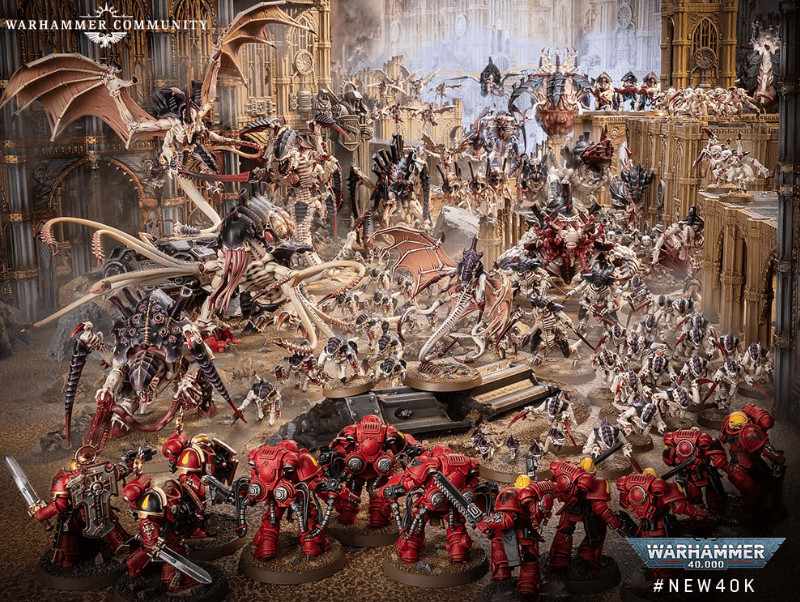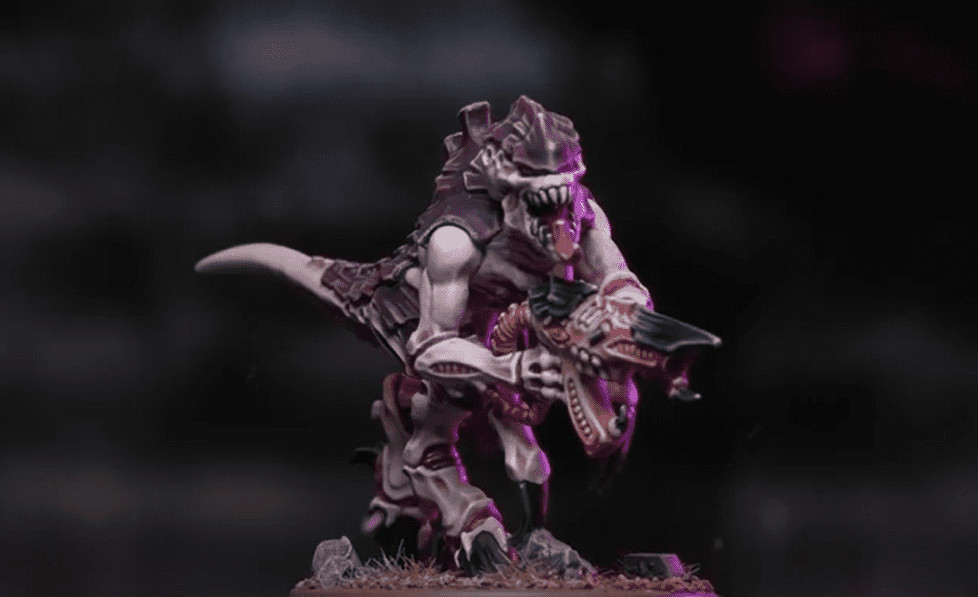 Uncover the relentless army strategies of the Tyranids with this Warhammer 40k playstyles guide, and learn more about hive minds and epic invasions!
Uncover the relentless army strategies of the Tyranids with this Warhammer 40k playstyles guide, and learn more about hive minds and epic invasions!
Updated December 26th, 2024, by Rob Baer with the latest information and links.
The Tyranids are here, and they’re hungry—for victory and maybe a little biomass on the side. If you’ve ever wondered how to wield this swarm of alien terrors to dominate the Warhammer 40k battlefield, you’re in the right place. This guide dives straight into their hive-mind strategies and unravels the secrets behind their devastating invasions.
Whether you prefer overwhelming your foes with sheer numbers or bringing elite bio-beasts to the fight, the Tyranids have a monstrous toolkit that’s as versatile as it is terrifying. Let’s crack open the hive and see what makes this faction tick (or chitter).
Unleashing the Tyranids & the Hive Mind’s Wrath

Their unique strategies offer layers of tactical depth, ensuring players can devour the competition in more ways than one. Let’s sink our teeth into how these galaxy-eaters operate and why they remain one of the most fascinating armies in the game.
Tyranid Combat Strategies: Feast on the Battlefield

This synergy gives Tyranids their signature adaptability. Got an Ork mob charging toward you? Send in waves of agile Hormagaunts to pin them down while your more specialized units flank them. Facing the cold, calculated firepower of Necrons? Deploy your towering Tyrant Guard to absorb incoming shots while your swarm closes the distance for a glorious melee feast.
One question that often pops up is, “Do Tyranids ever fight demons or orcs?” Spoiler: they absolutely do, and the results aren’t pretty—for the opposition. Tyranids view the universe through a simple lens: food or not-food.
Demons? They may not be entirely organic, but they’re close enough for Tyranids to rip apart. Orcs? Oh, that’s just a snack with extra muscle. The Hive Mind isn’t picky, and it’s frighteningly effective at taking down any foe, from bio-forms to warp-spawned monstrosities.
Onslaught Swarm Tactics: Hormagaunts, Genestealers, and Pure Chaos

But it’s not just about cannon fodder. Genestealers bring a terrifying mix of speed and lethality, slipping through gaps in enemy lines to slice apart key units with precision strikes. Meanwhile, monstrous support units like Carnifexes and Hierophants lurk in the wings, ready to smash through tanks or elite infantry once the little guys have done their job. These would also be perfect for the Cavill and Amazon series!
And let’s not forget the artistic side of this swarm-heavy playstyle. Tyranids offer some of the most fun painting schemes in Warhammer 40k. Whether you’re going for a vibrant alien palette or something darker and more menacing, the swarm aesthetic gives you plenty of room to let your creativity shine. Bonus points for gooey, slimy details—they add to the unsettling vibe that Tyranids embody so well.
Leviathan Tyranids Approach: The Thinking Predator

Tyrant Guard, Hive Tyrants, and Tyranid Warriors headline this approach, offering the durability and offensive power to smash through even the most stubborn defenses. The hallmark of the Leviathan strategy is adaptability. Thanks to the synaptic web that connects your units, the Hive Mind can quickly shift tactics to counter any threat.
Facing a Necron phalanx? Leviathan units are built to withstand punishing firepower, ensuring your swarm isn’t wiped off the board before reaching the enemy. If you’re curious about matchups like Necrons vs. Tyranids, Leviathan’s resilience and flexibility make them a nightmare for even the most meticulous opponents.
The Hungry Hive: Breaking Down Tyranids in Warhammer 40k

Characteristics of Tyranids
Tyranids are a species unlike any other in the Warhammer 40k universe. They don’t have traditional technology or machinery. Instead, every tool, weapon, and war machine is part of their biology. Need an anti-tank weapon?
Tyranids create bioforms capable of launching acidic projectiles or shredding armor with massive claws. From the smallest Hormagaunts to towering Hierophants, every Tyranid is bred with a specific purpose, and they all work together under the direction of the Hive Mind.
The Hive Mind is the Tyranids’ collective consciousness, ensuring the swarm acts as a single, coordinated organism. It’s not just terrifying—it’s efficient. This allows Tyranids to overwhelm opponents with numbers, strategy, or brute force, depending on the situation. Whether you’re fielding Tyranid Warriors or a swarm of Termagants, their connection to the Hive Mind ensures they fight with a singular, relentless purpose.
Biological Composition

One popular question is whether Tyranids are immune to things like radiation. The answer? Pretty much. Tyranids adapt to hostile environments with ease, making them incredibly resilient. This ability to survive and thrive in extreme conditions only adds to their mystique. They’re not just an invading force; they’re a force of nature.
Adaptations and Variability
Tyranids don’t just evolve over centuries—they adapt in real time. This makes them one of the most versatile factions in Warhammer 40k. Facing an army of heavily armored foes? Tyranids can field units like Tyrant Guard or Hierophants to smash through tough defenses. Need speed and agility? Hormagaunts and Genestealers will rip through the battlefield faster than your opponent can react.
Each Tyranid Hive Fleet has its own flavor, with Hive Fleet Leviathan being one of the most famous for its tactical versatility. Leviathan Tyranids are known for their durability and their ability to adapt mid-battle, making them a favorite among players who love a well-rounded approach. Their ability to mix swarms of smaller creatures with devastatingly powerful monsters like Carnifexes ensures that no two games against Tyranids feel the same.
For hobbyists, Tyranid painting schemes are another highlight. With their alien textures and organic designs, Tyranid miniatures allow for endless creativity. Bright, insect-like colors? Dark, menacing hues? Slimy, goo-covered carapaces? It’s all fair game, and it adds a level of artistry to an already fascinating faction.
The Tyranid Hive Mind: The Ultimate Galactic Overlord

Understanding the Tyranid Hive Mind
At the heart of every Tyranid invasion lies the Hive Mind. Think of it as the ultimate puppet master, guiding its swarm with an intelligence that feels more like a force of nature than a traditional leader. Unlike most armies that rely on orders shouted across the battlefield, Tyranids operate as a single entity. Every claw swipe, venom spit, and tail lash is perfectly coordinated, as if the swarm were a giant, nightmarish symphony.
What makes the Hive Mind so terrifying is its adaptability. It doesn’t just react—it learns. During battles, it gathers data on its enemies, tweaking its strategies for maximum efficiency. This ability to evolve on the fly ensures that Tyranids stay one step ahead, even against foes as unpredictable as demons or as disciplined as Necrons.
Synapse Creatures: The Hive Mind’s VIPs

Tyranid Warriors, Hive Tyrants, and Zoanthropes are some of the most notable synapse creatures, and their importance on the battlefield can’t be overstated. Without them, lesser Tyranid organisms like Hormagaunts and Termagants would revert to instinct, acting more like feral beasts than a cohesive army. Synapse creatures ensure that even the smallest Tyranid acts with deadly precision, transforming a chaotic horde into an unstoppable wave.
This interconnected system is part of what makes Tyranid gameplay so unique. Lose your synapse creatures, and your swarm risks falling apart. But keep them safe, and you’ll maintain an army that’s as efficient as it is terrifying. This dynamic adds an extra layer of strategy for players building their Tyranid combat patrol or full-scale invasion.
Role in Tyranid Communication
Tyranid communication isn’t about words or signals; it’s pure psychic energy. The Hive Mind speaks through its synapse network, transmitting commands instantaneously across the battlefield. There’s no room for misinterpretation—every Tyranid knows its role, from the smallest Ripper Swarm to the towering Hierophant.
This psychic network is also what allows the Hive Mind to adapt so quickly. By gathering and processing information from every creature in its swarm, the Hive Mind adjusts its approach in real time. The result? A relentless, coordinated assault that leaves even the most prepared enemies scrambling.
Tyranid Warriors and Units: Meet the Devourer’s Arsenal

At the heart of any Tyranid force, you’ll find the versatile Tyranid Warriors. These mid-sized creatures are more than just fodder; they’re the Swiss Army knives of the swarm. Equipped with a range of melee and ranged options, Tyranid Warriors can adapt to whatever battlefield challenge comes their way. Need to punch through armor? They’ve got monstrous strength. Need to pin down a squad from afar? Their bio-weapons will have you covered. But they’re not just about raw power—they’re also synapse creatures, anchoring the swarm with psychic control.
Tyrant Guard: The Hive Tyrant’s Personal Bodyguards
If you’re bringing a Hive Tyrant to the battlefield, you’ll want to keep it alive. That’s where the Tyrant Guard comes in. These hulking monstrosities are built to tank damage for their leader, acting as a living shield that shrugs off blows that would obliterate lesser creatures.
Tyrant Guard don’t just stand there looking scary—they’re absolute powerhouses in close combat. With their crushing claws and scything talons, they can hold their own against even the most elite enemies. Combine that with their incredible resilience, and you’ve got a unit that not only protects your Hive Tyrant but also delivers devastating blows of its own.
Hormagaunts and Their Role in the Swarm

Hormagaunts might not be the most durable units, but their strength lies in numbers. A squad of these little terrors can flood the battlefield, overwhelming enemies through sheer volume of attacks. They’re the perfect choice for locking down key threats while the rest of your swarm moves into position. In larger Tyranid swarms, Hormagaunts often act as a living tide, cutting off escape routes and forcing your opponent into unwinnable situations.
Hierophant Tyranids: The Colossal Nightmare

But what really sets the Hierophant apart is its durability. Capable of soaking up ridiculous amounts of firepower, it forces your opponent to divert their attention from the rest of your swarm. And while they’re busy dealing with the Hierophant, your smaller Tyranid units can move in for the kill. For any 40k Tyranids player looking to dominate both visually and strategically, the Hierophant is a must-have monster.
Tyranid Lore and Miniatures: Building the Perfect Swarm

What Are Tyranids?
Tyranids are the ultimate apex predators, engineered for one thing: consuming everything in their path. They don’t build, they don’t negotiate, and they certainly don’t care about borders. Their galaxy-spanning Hive Fleets descend on planets, strip them of resources, and move on to the next victim in their endless search for biomass.
The Hive Mind—the singular consciousness controlling every Tyranid unit—coordinates their efforts, ensuring that every claw, fang, and bio-cannon is part of a greater plan. From small creatures like Hormagaunts to colossal monstrosities like the Hierophant, every Tyranid serves a purpose.
Historical Context in Warhammer 40K

Tyranids have clashed with almost every major faction, from the stalwart Necrons to the savage Orks. Iconic matchups like Necrons vs. Tyranids highlight the clash between the ancient, calculated precision of the Necrons and the raw, biological ferocity of the Tyranids.
Painting Schemes for Tyranids

Classic Hive Fleets like Leviathan feature striking contrasts: white carapaces and rich purple details that give them an otherworldly appearance. If you’re into customizing, Tyranids practically beg for creative flair—iridescent carapaces, dripping bio-acid effects, or even glowing eyes can make your swarm stand out. And because they’re organic, imperfections can add to their realism, so experimenting with washes and textures is highly encouraged.
Popular Miniatures and Collecting Tips
The Tyranid range has something for everyone, whether you prefer small, nimble units or towering monstrosities. For beginners, the Tyranids Combat Patrol is a great starting point, offering a mix of basic troops and a few heavy hitters. Hormagaunts, Termagants, and Tyranid Warriors are essential for most lists, and they give you plenty of practice painting swarm-style armies.
Collectors often gravitate toward centerpiece models like the Hive Tyrant or the Hierophant. These massive creatures not only dominate the battlefield but also make for stunning display pieces. For fans of Tyranid lore, adding units like Tyrant Guard or the unique Genestealer Cult hybrids can bring narrative depth to your collection. And don’t forget—Tyranids love variety, so mixing and matching units from different Hive Fleets or creating your own custom swarm is always an option.
Tyranid Invasions: The Galactic Banquet of Warhammer 40k

Famous Tyranid Invasions

One of the most iconic invasions is the assault of Hive Fleet Behemoth on Ultramar, home to the Ultramarines. This was the Imperium’s first encounter with the Tyranids, and it was nothing short of catastrophic. Though the Ultramarines managed to repel the invasion, it came at a devastating cost, with entire worlds consumed before Behemoth was finally defeated. This battle cemented the Tyranids’ reputation as one of the greatest threats to the galaxy.
Hive Fleet Kraken brought a new flavor of terror. Splintering into smaller, more agile fleets, Kraken demonstrated the Tyranids’ ability to adapt and evolve their strategies. This invasion introduced the galaxy to the concept of fighting not just a single Hive Fleet but countless smaller ones, each just as deadly as the last.
And then there’s Hive Fleet Leviathan, which struck from below the galactic plane—a direction no one expected. Leviathan Tyranids used sheer numbers and brutal adaptability to swarm countless worlds, showcasing their horrifying ability to overwhelm even the most prepared defenders.
Genestealer Cults and Their Importance

Genestealer Cults form when Tyranid Genestealers infect unsuspecting hosts, implanting their genetic code into them. Over generations, this infection spreads, creating a secretive cult that worships the Hive Mind. By the time the Tyranid Swarm arrives, the cult has already sown chaos, weakening planetary defenses and ensuring an easier conquest.
These cults aren’t just lore-heavy—they’re also a fascinating gameplay option. For players, integrating Genestealer Cults into a Tyranid army adds a layer of strategy, allowing for subterfuge and surprise attacks. Plus, the miniatures are a painter’s dream, blending Tyranid bioforms with the industrial aesthetic of 40k’s human factions. Their unique designs make them a standout on the tabletop and a reminder that Tyranid invasions begin long before the first claws hit the ground.
Final Thoughts on Tyranids in Warhammer 40k

A Tyranid invasion isn’t just a battle—it’s an event. Famous Hive Fleets like Leviathan and Kraken have devastated entire sectors with their relentless onslaught swarm tactics, leaving even the stalwart Imperium scrambling to recover. And yes, for those curious, Tyranids absolutely take on demons, orcs, or anything else unlucky enough to cross their path. To the Hive Mind, it’s all just biomass for the grinder.
Warhammer 40k Factions Explained: A Complete Guide to Every Army
What do you think about the Tyranids in Warhammer 40k? Do you like the playstyle and units in 40k?





